Contents
A “vehicle reconditioned” label is an important term to review. It means the car has been inspected, repaired, and restored. The goal is to reach a marketable condition. For a car dealership, the goal isn’t just to make a car look newer. It’s about ensuring quality that stands up to buyer expectations. However, with so many reconditioned vehicles on the lot, how can you tell which ones are worth the price? Reading what goes into this process can help you make smarter, safer decisions when buying a used car.
Definition of a Reconditioned Vehicle
The vehicle reconditioned meaning refers to a used car that has undergone inspections and improvements. The goal is to restore the automobile to a sellable condition. These aren’t just cosmetic touch-ups. Procedures often involve necessary repairs to different car parts. These may be safety systems, drivetrain components, or electrical features. Most dealerships utilize reconditioning to meet resale standards. This helps maintain the car is safe and presentable. Additionally, it’s a way to add value and improve a used car’s appeal.
By handling necessary repairs upfront, reconditioning helps mitigate the threat of immediate maintenance costs for the next owner. For most dealerships, it’s a strategy to offer cleaner, more reliable vehicles that hold up in the long run. When performed correctly, it can increase buyer confidence. Furthermore, the dealership’s reputation is safeguarded. However, not all reconditioned cars are equal. The quality depends on what was fixed, how it was done, and who performed the work.
What Is Included in a Car Reconditioning Process?
The used car reconditioning process implies preparing a trade-in or auction vehicle for resale. Buyers search for quality vehicles only. Thus, cars should be safe, functional, and visually appealing.
Common tasks include:
- Inspection by diagnostic technicians for engine, brakes, and electronics.
- Fixing dents, scratches, and windshield cracks.
- Oil change, filter replacement, and fluid top-offs.
- Repairing or replacing tires and brakes.
- Detailing interior and exterior surfaces.
- Checking if the car has an open recall and completing required recall work.
- Verifying emission and safety compliance before resale.
SCA Auctions Insight: More than 30% of vehicles sold through SCA Auctions in Q1 2025 underwent cosmetic reconditioning before being listed. The most common fixes included windshield chips, bumper scuffs, and worn tires.
Who Performs Car Reconditioning – and Where It Happens

A new car dealership often performs vehicle reconditioning in its service department, where certified technicians handle everything from engine checks to upholstery fixes. These shops rely on skilled specialists, including paint experts, to restore a vehicle’s look and feel to match buyer expectations. Independent garages and auction centers also handle reconditioning, especially for high-volume inventory. Dealers invest in this process not only to move used cars faster but also to earn trust, build repeat business, and protect their brand’s reputation.
According to SCA Auctions data, Florida (16%), Texas (14%), and Georgia (9%) lead the nation in reconditioned vehicle volume, together accounting for 39% of all reconditioned auction units in Q1 2025. These states rely on fast-turn service lanes to keep inventory moving in competitive metro areas like Miami, Dallas, and Atlanta.
Reconditioning vs. Repairs vs. Detailing: Know the Difference
Grasping the distinctions between reconditioning, repairs, and detailing is vital. It helps buyers realize where to invest their time, whether they’re prepping a vehicle for business use or trying to avoid spending more money later.
| Category | Purpose | Typical Work | Who Uses It |
| Reconditioning | Broad vehicle refurbishment to restore resale value | Tires, brakes, paint, minor mechanical issues | Many dealerships, auction houses |
| Repairs | Fixing damage or broken systems | Engine repair, transmission, suspension | Individual owners, insurance claims |
| Detailing | Cosmetic cleaning and touch-ups | Wash, wax, vacuuming, stain removal | Car shows, resale prep |
SCA Auctions Insight: Reconditioned units sell 17% faster post-auction than raw trade-ins or ‘as-is’ units. Dealers sourcing vehicles from SCA Auctions typically prioritize reconditioning over repairs or detailing.
What Does “Vehicle Reconditioned” Mean in a Vehicle History Report
Buyers often ask, what does vehicle reconditioned mean when it shows up on a history report. It signals that the used vehicle underwent repairs or upgrades before resale, usually after a professional inspection flagged areas needing attention. This can range from mechanical fixes to cosmetic restoration. The car’s condition determines the necessary procedures. When checking a vehicle’s past, tools like a VIN decoder can reveal reconditioning events and highlight how well the car was prepared for its next owner.
Can You Trust a Reconditioned Car?
A professionally reconditioned vehicle can meet or exceed safety standards when the work is done thoroughly and documented properly. Look for signs like new tires, clean interiors, and paint treatments that match factory quality, and always request service records before buying. A test drive remains essential to check how the vehicle feels in motion and whether the moving parts operate smoothly.
Most Reconditioned Makes and Models
The best cars to restore are often those with high resale demand and reliable service histories.
SCA Auctions Insight:
“Our Q1 2025 post-auction retail tracking shows that reconditioned Honda Civics, Toyota Camrys, and Ford Escapes are top performers, typically moving to retail buyers in less than two weeks. These models combine reliability, easy financing, and consistent demand – making them low-risk bets for dealers.”
The Risks of Poorly Done Reconditioning
Quick cosmetic fixes can hide serious flaws. Some dealers skip mechanical work to save time and money, applying fresh paint or changing floor mats to make a vehicle look clean without addressing engine wear, brake issues, or frame damage. Cosmetic-only work can lead to breakdowns, expensive repairs, and even legal headaches if damage isn’t disclosed properly. Worse, poorly reconditioned cars often lose value faster and can be harder to resell or trade in.
Red Flags – Paint Inconsistencies, Poor Panel Alignment, Rust Cover-Ups
To spot a low-quality job, use these visual and practical checks:
- Look closely at the paint: Mismatched shades or uneven texture may signal panel replacements or quick cover-ups.
- Check panel alignment: Doors, trunk, or hood should close smoothly. Gaps or misalignment hint at previous accidents.
- Inspect for rust cover-ups: Fresh paint near wheel wells, rocker panels, or the undercarriage may hide corrosion.
- Open the hood and trunk: Dirty engine components in an otherwise spotless car suggest a surface-only cleanup.
- Ask for documentation: A quality job includes clear service records. Vague summaries are a red flag.
How Car Reconditioning Affects Trade-In Value at Dealerships
Reconditioning helps vehicles sell faster and allows dealerships to increase car sales without sacrificing gross profit margins, especially when upgrades align with current market value.
| Reconditioning Impact | Benefit to Dealership | Impact on Trade-In Offer |
| Cosmetic upgrades | Boost curb appeal | Slightly improved offer |
| Mechanical improvements | Reduces post-sale issues | Higher trade-in valuation |
| Full inspection and rework | Builds buyer trust | Adds leverage in negotiation |
| Service documentation | Increases transparency | Supports premium pricing |
Can You Recondition a Car Yourself?
DIY reconditioning works best when the vehicle is in solid condition and only needs cosmetic or basic upkeep. Private sellers can often handle cleaning, polishing, minor trim work, and fluid checks without much risk. What you can’t safely do at home is anything involving safety-critical systems, engine internals, or electrical diagnostics. Think of it this way: if a task involves unbolting a part connected to suspension, brakes, or the powertrain, it’s time to call a pro.
Tools You’ll Need – Touch-Up Kits, Polishers, Cleaners

- Microfiber cloths and interior cleaning sprays
- Paint touch-up kits for chips or scratches
- Orbital polishers to restore surface shine
- Wheel cleaners and tire shine
- Plastic restorer for trims and headlights
- Basic socket set and fluid funnels
- OBD-II scanner for error codes
DIY steps
- Start with a deep clean inside and out, removing stains and odors.
- Use paint kits for chips and scratches, and polish dull areas.
- Fix minor bumper damage, wiper replacements, or lightbulbs.
- Inspect and top off fluids: oil, coolant, washer fluid, brake fluid.
- Clean or replace floor mats and restore faded trim or emblems.
Know when to stop: According to industry data, nearly 62% of used car returns within 30 days are linked to overlooked mechanical faults during private sales. Critical systems like brakes, airbags, and engine sensors are not DIY-friendly. If you spot fluid leaks, warning lights, odd noises, or can’t resolve climate control issues, don’t go further. Those are signs you need a professional. Safety systems and mechanical repairs shouldn’t be handled without proper training.
Summary
Auto reconditioning plays a critical role in today’s used car market. It bridges the gap between trade-ins and retail-ready inventory. When you see a vehicle reconditioned, it usually means it’s gone through mechanical repairs, thorough cleaning, and cosmetic fixes. Smoothing out dents is among the popular procedures. These improvements can boost safety, appearance, and overall value. Final thoughts: while not every reconditioned car guarantees long-term reliability, those that show proper documentation and consistent care often deliver solid performance and peace of mind for buyers.
FAQ
Are Reconditioned Car Parts Good?
It depends on the source and the type of part. High-quality reconditioned components can perform close to new. They are commonly utilized for engines, transmissions, and alternators. However, they should come with warranties and proper testing documentation.
Can I Refuse to Pay Dealership Reconditioning Fees?
Yes, but only during price negotiations. Many dealerships include these fees in the listed price. Alternatively, they add them as a separate line item. The cost may be considered excessive or not justified. In this case, ask for a breakdown and negotiate before signing any paperwork.
How Long Will a Reconditioned Engine Last?
A professionally restored engine can run over 100,000 miles. Proper installation and regular maintenance are, certainly, vital conditions. Lifespan depends on how extensive the rebuild was. Moreover, the technician’s skills should be taken into account. Also, pay attention to whether original parts were replaced or repaired.
Does Vehicle Reconditioning Void a Car’s Warranty?
Not necessarily. The work is typically performed by a certified technician. Additionally, when manufacturer-approved parts are used, the warranty remains valid.
How Do I Know If a Car Was Only Cosmetically Reconditioned?
Look beyond clean surfaces. A quick vehicle reconditioned label without detailed service records can signal cosmetic-only work. Ask for mechanical inspection reports, look under the hood, and consider getting an independent assessment before purchase.





